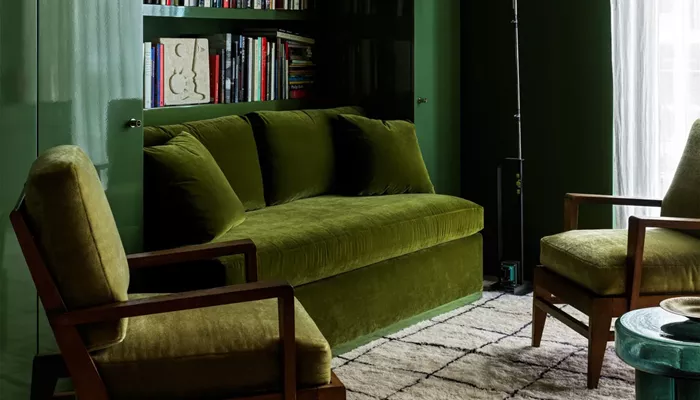In the ever-changing world of interior design, trends come and go. Remember the era of mid-toned grays that took the design world by storm in the 2010s? It was a modern rebellion against the Tuscan-era design style, but soon enough, “millennial gray” became a thing of the era, seen as outdated and unexciting. Now, a new trend on social media has people wondering if green is heading down a similar path.
Livingetc’s editor, Hugh Metcalf, understands the source of the concern. He notes that there’s a growing feeling that a one-note neutral decorating scheme isn’t ideal, leading people to seek new contrasts. For those who are averse to color, a grayish-sage green can be an easy choice, but it brings new connotations to the homes where it’s used.
So, is green the new “millennial gray” or “sad beige”? Amy Moorea Wong, Livingetc’s color expert, firmly believes it’s not. Green has been a staple in home decor for years and offers much more variety than more neutral shades. Wong passionately declares that as the color of nature, green will never go out of style. It’s an essential part of our lives, representing forests and rolling hills, and it has a special place in our homes and hearts.
Green room ideas have a unique ability to make our homes feel grounded, soothed, invigorated, and connected to nature in a way that other colors, especially gray and beige, can’t match. Amy adds that bringing green into our homes was a great idea, and it’s hard to argue that it doesn’t look and feel good.
However, getting green right in home decor has its nuances. Australian interior designer Sally Wilkins explains that the label “millennial green” reflects a continued preference for a minimalist aesthetic in interior design, but with a bit more color. While green has depth and can create contrast and visual interest, too much of it can make a space feel cold and clinical, the opposite of the refreshing feeling that nature provides.
The popularity of green trends over the past few years might also be a factor in the current discussion. Amy Moorea Wong points out that green has been a topic of conversation for longer than most color trends, and we often have a penchant for chasing new, experimental hues. Sage green, for example, is a beautiful color, but it may not be as bold and unexpected as some might like for home decor.
Another reason green might seem a bit boring is that it’s often been touted as a “neutral” color, making it blend into the background. But Amy doesn’t hold this against green. Its prominence doesn’t detract from its power to calm and act as a decorative balm.
The good news is that avoiding the “millennial green” effect doesn’t mean avoiding green altogether. There are many ways to incorporate the color in a fresh and contemporary manner, such as through layering with other colors, materials, and finishes.
Amy suggests that instead of aiming for a green theme or emulating a woodland, we should think of green as an accent color, part of a wider color palette rather than the dominant hue. Sally advises creating interest by using colors that either contrast with or complement green. Green should be considered as a primary accent color rather than the main wall color, and pops of green can be introduced through upholstery and textiles.
Most importantly, to avoid veering into “millennial green”territory, we should avoid pairing green with an otherwise neutral color scheme. Sally recommends introducing a secondary color to complement green and a third accent color, like soft yellows or blush pink, to add visual interest. Using the color wheel to figure out which colors go well with green is a great guide.
Alternatively, we can go all out and use green as the base color, but we should pair it with natural elements for warmth and texture and accent colors for visual interest to prevent the space from feeling cold and clinical.
Amy’s preferred green shades are on the deep and edgy side, such as dirty olive, muddy crocodile, or mossy colors, with a splash of pistachio to liven things up. Sally leans towards natural, statement-making tones like muted soft olive greens or tobacco hues, which harmonize beautifully with other colors.
Green has served as an effective alternative to the potentially “boring” palettes of beige, gray, white, and cream that have dominated interior design trends in the past decade. But it doesn’t have to share the same fate as “millennial gray.” By finding the right ways to use it, green can truly flourish in our homes, rather than being seen as just a short-term design fix.
Related topics:
- Luxury Goods Face a Fake News Problem. Is Silence the Right Strategy?
- Gucci Crisis Deepens, Kering’s Q1 Sales Fall More Than Expected
- Gucci Reopens Its Boutique at Beverly Center in Los Angeles

